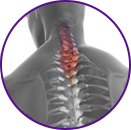Cervical Degenerative Disorders

Cervical refers to the 7 vertebrae of the neck. The cervical spine consists of other anatomic structures including muscles, bones, ligaments and joints. Normally, the cervical spine permits quite a range of flexibility and motion. However it is susceptible to physical forces during traumatic injuries. This high range of motion encourages changes associated with spinal wear and tear or age.
Some of the cervical degenerative disorders include:
Degenerative disc disease: Degenerative disc disease refers to gradual deterioration of the disc between the vertebrae and is caused due to ageing. As people age, intervertebral discs lose their flexibility, elasticity and shock absorbing characteristics. Depending on the location of degenerative disc, it could cause back pain, radiating leg pain, neck pain and radiating arm pain.
Compression of the spinal cord:Degenerative disc disease may cause narrowing of the spaces between the vertebral bodies, which indicate that the disc has become very thin or has collapsed. As a result, the space available for the nerve roots starts to shrink. The nerve roots leave the spinal canal through a bony tunnel called the neural foramen and it is at the neural foramen that the nerve roots may get compressed. Compression of the spinal cord causes pain, difficulties with mobility, bladder control problems, weakness and fatigue.
Cervical Stenosis: Cervical stenosis refers to narrowing of the spinal canal that protects the spinal cord and its branching nerves. The condition causes neck pain radiating to arms and hands, numbness or weakness in the legs. This condition causes cervical myelopathy and cervical radiculopathy. The abnormal pressure placed on the spinal cord causes damage and results in spinal cord dysfunction. This condition is known as myelopathy. Cervical radiculopathy occurs when the nerve root connecting the spinal cord is injured or pinched as they exit the spinal canal. Myeloradiculopathy occurs when there is damage to the spinal cord and nerve roots.
Cervical Disc Herniation: A cervical disc herniation is a condition affecting the neck, in which the outer fibers surrounding the disc (annulus fibrosis) may cause tears or cracks. As a result of this, the soft central portion called nucleus pulposus bulges out through the tear in the capsule. The condition can be caused by the normal ageing or by traumatic injury to the spine. The condition results in painful burning, tingling or numbing sensations in the neck, shoulders, arms and hands.
Cervical Spondylosis: Cervical spondylosis refers to a disorder in which there is abnormal degeneration of the cartilage and bones of the neck. The condition results in neck pain radiating to arms or shoulder and neck stiffness that gets worse over time.
Rheumatoid Arthritis: It is an auto-immune disease in which the body’s immune system attacks healthy joints, tissues and organs. The condition occurs most often in women of childbearing age, causing inflammation of the lining (or synovium) of joints resulting in pain, stiffness, swelling and loss of function in the joints.
Diagnosis
Diagnosis of cervical spine disorders is made with physical examination and other imaging techniques including electromyography (EMG), X-ray, MRI scan, CT scan, blood tests and bone density assessment.
Treatment
Conservative treatment
- Medications: Anti-inflammatory drugs, analgesics and muscle relaxants may be prescribed to reduce the pain and inflammation.
- Physical Therapy: A wide range of exercises for flexibility, toning, strengthening, stability and restoration of range of motion may be recommended.
Surgical Treatment
An anterior cervical discectomy with spinal fusion is typically recommended only after non-surgical treatment methods fail.
Other Conditions List
- Spine Deformities
- Degenerative Disc Disease
- Herniated Disc (Lumbar)
- Herniated Disc (Cervical)
- Cervical Stenosis
- Lumbar Stenosis
- Cervical Disc Protrusion
- Sciatica
- Scoliosis
- Spine Tumors
- Spondylolisthesis
- Ankylosing Spondylitis
- Adult Kyphosis
- Adult Kyphosis-Types and Causes
- Scheuermann’s Kyphosis
- Back Pain
- Neck Pain
- Mid-back Pain
- Sacroiliac Joint Dysfunction
- Spine Trauma
- Spinal Injuries at work
- Spinal Fractures
- Spondyloarthropathies
- Spondylolysis
- Facet Joint Arthritis
- Piriformis Syndrome
- Whiplash
- DISH (Diffuse Idiopathic Skeletal Hyperostosis)
- Burners and Stingers
- Myelopathy
- Degenerative Spine
- Vertebral Fractures




 Menu
Menu